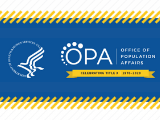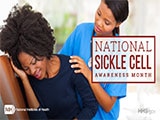Coming Together to Confront Sickle Cell Disease
Hope has never been higher for people living with sickle cell disease (SCD) and their families and supporters. With the possibility of a widely available cure within reach, a pipeline of new treatments on the horizon and several initiatives underway to better utilize current tools in the battle against the painful and deadly blood disorder, the opportunity before us in the coming months and years is profound and historic.
As we mark World Sickle Cell Day on June 19, this flurry of notable progress is a reason for considerable excitement in the sickle cell community and among all of us at the U.S. Department of Health and Human Services (HHS) and across the Trump Administration. We’re also at a pivotal point for healthcare policymakers and other professionals in both the public and private sectors to engage the SCD community about what can be done to take advantage of the medical and scientific opportunities.
At HHS and other aligned institutions, there is unprecedented activity in SCD research. Important work is underway to identify and address barriers to care for children and teens, as well as adults, and several organizations are developing education and training programs to help providers treat patients with the disease. We are also exploring new payment models to enable patients with SCD to get the comprehensive medical care and services they require.
SCD is an inherited disorder, primarily among African Americans and Hispanics, resulting from a genetic mutation that causes red blood cells to form an abnormal sickle shape. This can cause severe and debilitating pain in people with the disease when rigid and sticky sickle cells adhere to the walls of small blood vessels, blocking the flow of blood and depriving the body’s tissues of blood and oxygen, potentially leading to life threatening infections, lung and other organ damage, blindness, heart failure, strokes and premature death.
This disease is common enough in the United States that there are about 100,000 people currently living with SCD, but uncommon enough that medical professionals rarely see SCD patients. Only about 1 in 4 patients with SCD receive the standard of care described in current guidelines, and many studies have shown that patients do not receive treatment for their pain as soon as or in the appropriate doses as other patients.

At HHS, we are committed to extending the lives of Americans with SCD by 10 years, within 10 years. In 2018 we organized and convened the HHS Sickle Cell Disease Workgroup, bringing together 60 members from 11 HHS agencies to align efforts and prioritize SCD activities. Early priorities for the workgroup include addressing the challenges patients face when transitioning from pediatric care to finding providers who treat adults with the disease. As well as expansion of data collection efforts, such as the Sickle Cell Data Collection (SCDC) System at the Centers for Disease Control and Prevention. Also encouraging is the number of new investigational drugs under review by the U.S. Food and Drug Administration over the last few years. In the last century, there have been only two drugs to treat SCD. Today, there are approximately 40 drugs to help patients better manage pain and other complications currently being tested in clinical trials.
Pain management objectives also include helping patients with SCD avoid getting swept up in treatment challenges associated with opioid overprescribing. We want to decrease the inappropriate use of opioids, while still helping patients who experience real and excruciating pain. Patients with SCD should have access to compassionate, non-stigmatizing care. In the future we hope to have other drugs, but right now opioids often provide the appropriate type of pain relief that all of us would expect.
At the National Institutes of Health, the National, Heart, Lung, and Blood Institute (NHLBI) has initiated the Cure Sickle Cell Initiative to accelerate gene therapies to cure the disease. NHLBI says we’re on track to have a cure in the next 5 to 10 years; and when that happens, we want to assure that it is accessible and affordable to all who need it, and that healthcare providers are educated and prepared to deliver the optimal care and follow up required.
The drive for progress on SCD is not just domestic, but worldwide. In May, at the 72nd World Health Assembly in Geneva, we had the opportunity to convene a roundtable with African health ministers, health leaders, and SCD experts to discuss barriers to care. Sub-Saharan Africa has the greatest burden of disease, with more than 300,000 babies born with the disease each year. African government officials, healthcare workers, World Health Organization leaders, and development organizations met to discuss roadblocks in identifying and treating this disease. The roundtable was a galvanizing event, and resulted in a hope-filled launch of a working group to improve identification and care of SCD in Africa.
The momentum being generated around SCD here in the U.S. and in other parts of the world is helping raise the profile of the disease as a public health priority and draw attention to the work underway to create meaningful programs that immediately impact patients. President Trump is committed to the effort, signing into law a bill to improve SCD treatment, research, monitoring and prevention in December and then issuing a presidential message in September highlighting the current opportunity to improve the lives of people with SCD.
More than 100 years after sickle cell anemia was determined to be a molecular disease, we are at a turning point. In the early 1900s, a diagnosis of SCD was a virtual death sentence in childhood. Today, it is not. We have the ability to improve lives and are closer than ever to a cure that could be widely available. We are committed to making a tangible difference here in the U.S. and for those long suffering from this disease all over the world.
Everyone Plays a Role in Improving Immunization Rates and Prevent
NIH Adapts to the Changing Epidemiology of HIV Infection


